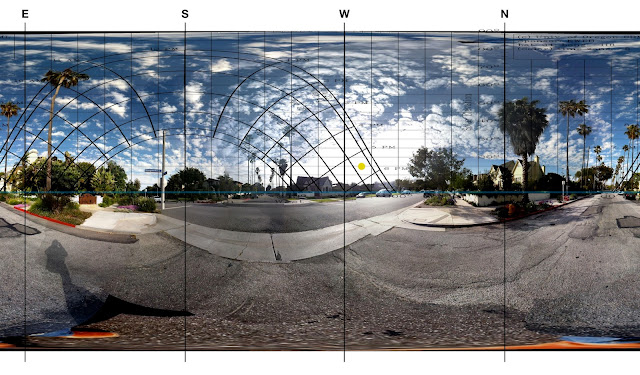
Reading Sun Path Diagrams
Sun path diagrams can tell you a lot about how the sun will impact your site and building throughout the year. Stereographic sun path diagrams can be used to read the solar azimuth and altitude for a given location.
Stereographic Sun Path Diagrams
Stereographic sun path diagrams are used to read the solar azimuth and altitude throughout the day and year for a given position on the earth. They can be likened to a photograph of the sky, taken looking straight up towards the zenith, with a 180° fish-eye lens. The paths of the sun at different times of the year can then be projected onto this flattened hemisphere for any location on Earth.
Note that these stereographic diagrams are not exactly like a fish-eye photo: such an image would be flipped left-to-right. These diagrams are from the point of view of the sky looking down at the ground, you can superimpose it on a map or a plan of the building without being confused. (You can see this by following the hour lines from east to west on the diagram.)
- Azimuth Lines - Azimuth angles run around the edge of the diagram.
- Altitude Lines - Altitude angles are represented as concentric circular dotted lines that run from the center of the diagram out.
- Date Lines - Date lines start on the eastern side of the graph and run to the western side and represent the path of the sun on one particular day of the year.
- Hour Lines/ Analemma - Hour lines are shown as figure-eight-type lines that intersect the date lines and represent the position of the sun at a specific hour of the day. The intersection points between date and hour lines give the position of the sun.
Reading the Sun Position (Step-by-Step)
- Locate the required hour line on the diagram.
- Locate the required date line, remembering that solid are used for Jan-June and dotted lines for July-Dec.
- Find the intersection point of the hour and date lines. Remember to intersect solid with solid and dotted with dotted lines.
- Draw a line from the very center of the diagram, through the intersection point, out to the perimeter of the diagram.
- Read the azimuth as an angle taken clockwise from north. In this case, the value is about 62°.
- Trace a concentric circle around from the intersection point to the vertical north axis, on which is displayed the altitude angles.
- Interpolate between the concentric circle lines to find the altitude. In this case the intersection point sits exactly on the 30° line.
- This gives the position of the sun, fully defined as an azimuth and altitude.
The articles on passive heating, cooling, and daylighting will describe how to design for bringing the sun's heat and light into the building at some times and keeping it out at other times.


